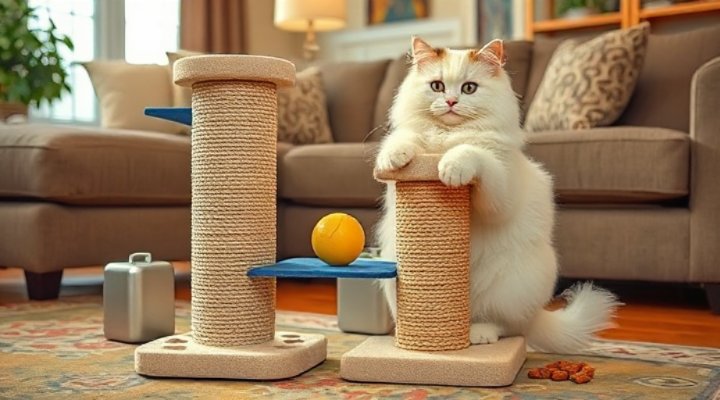In this comprehensive guide, we explore cat training techniques that empower you to teach your feline friend obedience, fun tricks, and proper behavior through positive reinforcement and consistent practice. From basic commands to advanced skills, you’ll discover how to build a strong bond with your cat while addressing common challenges. Whether you’re a new cat owner or looking to refine your approach, these methods will help you create a harmonious home environment. Above all, remember that patience and love are your best tools in this journey.

Understanding the Basics of Cat Training Techniques
Many people believe that cats are untrainable, but that’s a myth! In fact, cat training techniques rely on understanding feline psychology. Cats are independent creatures, so they respond best to methods that respect their nature. For example, using positive reinforcement—like treats or praise—encourages them to repeat desired behaviors. I recall when I first trained my cat, Whiskers; he went from ignoring me to eagerly responding to cues within weeks. Similarly, consistency is key; practicing daily, even for short sessions, builds trust and habit.
To start, focus on simple commands like “come” or “sit.” Use a clicker or a verbal marker to signal correct actions, followed immediately by a reward. Consequently, your cat learns to associate the behavior with something positive. Moreover, avoid punishment, as it can damage your relationship and lead to fear. Instead, redirect unwanted behaviors gently. For instance, if your cat scratches furniture, provide a scratching post and reward its use. In other words, cat training techniques are all about communication and mutual respect.
Essential Tools for Effective Cat Training
Having the right tools can make cat training techniques much smoother. Firstly, invest in high-value treats that your cat loves. These act as powerful motivators. Additionally, a clicker is invaluable for marking precise moments of good behavior. But, on the other hand, some cats prefer verbal cues, so experiment to see what works best. Furthermore, toys like wands or puzzles can incorporate play into training, making it fun for both of you.
During training sessions, keep tools organized and sessions short—5-10 minutes max. This prevents boredom and maintains engagement. Meanwhile, ensure a quiet, distraction-free environment to help your cat focus. As a result, you’ll see faster progress. For more insights on choosing the right supplies, check out our guide on Best Cat Food for Indoor Cats, as nutrition plays a role in your cat’s responsiveness.

Step-by-Step Guide to Basic Cat Training Techniques
Let’s dive into practical cat training techniques for beginners. Start with targeting: teach your cat to touch an object, like a stick, with its nose. Use a treat to lure it, and click or say “yes” when it touches. Subsequently, reward it. This builds foundation skills for more complex tricks. Next, move to “sit.” Hold a treat above your cat’s head; as it looks up, its bottom will naturally lower. Click and reward the moment it sits. Repeat this daily, and soon your cat will sit on cue.
Another useful command is “come.” Call your cat’s name and reward it when it approaches. Gradually increase distance and distractions. Importantly, always end sessions on a positive note with praise or a favorite activity. Likewise, for litter box training, place your cat in the box after meals and reward successful use. If issues arise, consult resources like the AVMA Cat Care Guide for expert advice. Through these cat training techniques, you’ll foster obedience and reduce problem behaviors.
Common Mistakes in Basic Cat Training
Even with the best intentions, mistakes can hinder progress in cat training techniques. For example, inconsistent timing with rewards can confuse your cat. Therefore, always reward immediately after the desired behavior. Additionally, training when your cat is tired or hungry may lead to frustration. So, schedule sessions after naps or meals. On the other hand, giving up too soon is common; remember, cats learn at their own pace. Persistence pays off, as I learned when Whiskers finally mastered “high-five” after many attempts.

Advanced Cat Training Techniques for Tricks and Agility
Once basics are mastered, advanced cat training techniques can teach impressive tricks and agility. For instance, teaching your cat to jump through hoops starts with luring it through a low ring with treats. Gradually raise the hoop and add verbal cues. Similarly, agility courses with tunnels and poles can provide mental and physical stimulation. Use positive reinforcement to guide your cat through each obstacle, building confidence and skill.
Moreover, trick training like “roll over” or “fetch” strengthens your bond. Break tricks into small steps and reward incremental progress. For example, for “fetch,” encourage your cat to chase a toy, then reward it for bringing it back. Consequently, many cats enjoy this game. To support this, ensure your cat is healthy and energetic; our article on Wet Cat Food Health Benefits highlights how proper nutrition boosts activity levels. In the same vein, these cat training techniques turn training into a joyful experience.
Incorporating Play into Advanced Training
Play is a natural part of cat training techniques for advanced skills. Use interactive toys to simulate hunting behaviors, which cats inherently enjoy. For example, hide treats in puzzle feeders to encourage problem-solving. Meanwhile, incorporate training into play sessions to keep things exciting. As a result, your cat stays engaged and learns faster. But, however, always monitor for signs of stress and adjust accordingly. Above all, keep it fun—your cat’s enthusiasm is the best indicator of success.

Addressing Behavioral Issues with Cat Training Techniques
Cat training techniques are not just for tricks; they’re crucial for correcting behavioral problems. For instance, scratching furniture can be redirected by providing appealing alternatives and rewarding their use. Similarly, for aggression, identify triggers and use desensitization—gradually exposing your cat to the trigger while rewarding calm behavior. Consequently, this reduces fear-based reactions.
Another common issue is excessive meowing. Teach a “quiet” command by rewarding moments of silence and ignoring attention-seeking meows. Additionally, ensure your cat’s needs are met, as discussed in our piece on Best Cat Food for Indoor Cats. If problems persist, seek guidance from the Humane Society’s Cat Training Tips. In other words, cat training techniques promote a peaceful home by addressing root causes with patience and consistency.
Preventing and Managing Litter Box Problems
Litter box issues are a top concern, but cat training techniques can resolve them. Firstly, ensure the box is clean and in a quiet location. If your cat avoids it, use positive reinforcement by placing it in the box after meals and rewarding use. Moreover, address medical issues with a vet, as health problems often underlie behavioral changes. For example, urinary issues might require special diets, like those in Royal Canin Urinary Care for Cats. By combining training with health care, you can overcome these challenges effectively.

Building a Lifelong Bond Through Cat Training Techniques
Ultimately, cat training techniques are about more than obedience—they’re a pathway to a deeper connection. Regular training sessions strengthen trust and communication between you and your cat. For example, when my cat learned to respond to his name, it felt like we were truly partners. Furthermore, training provides mental stimulation, reducing boredom and related issues like destructive behavior.
To maintain this bond, integrate training into daily routines. Use meal times for quick practice or play sessions for reinforcement. Similarly, celebrate small victories to keep motivation high. In conclusion, cat training techniques enrich your cat’s life and yours, fostering a happy, well-adjusted pet. Remember, every cat is unique, so adapt methods to suit their personality. With love and consistency, you’ll achieve amazing results.
Related Keywords: cat training, positive reinforcement, cat behavior, obedience training, trick training, feline training, cat care, pet training, clicker training, cat agility, behavioral correction, litter box training, bonding with cats.
